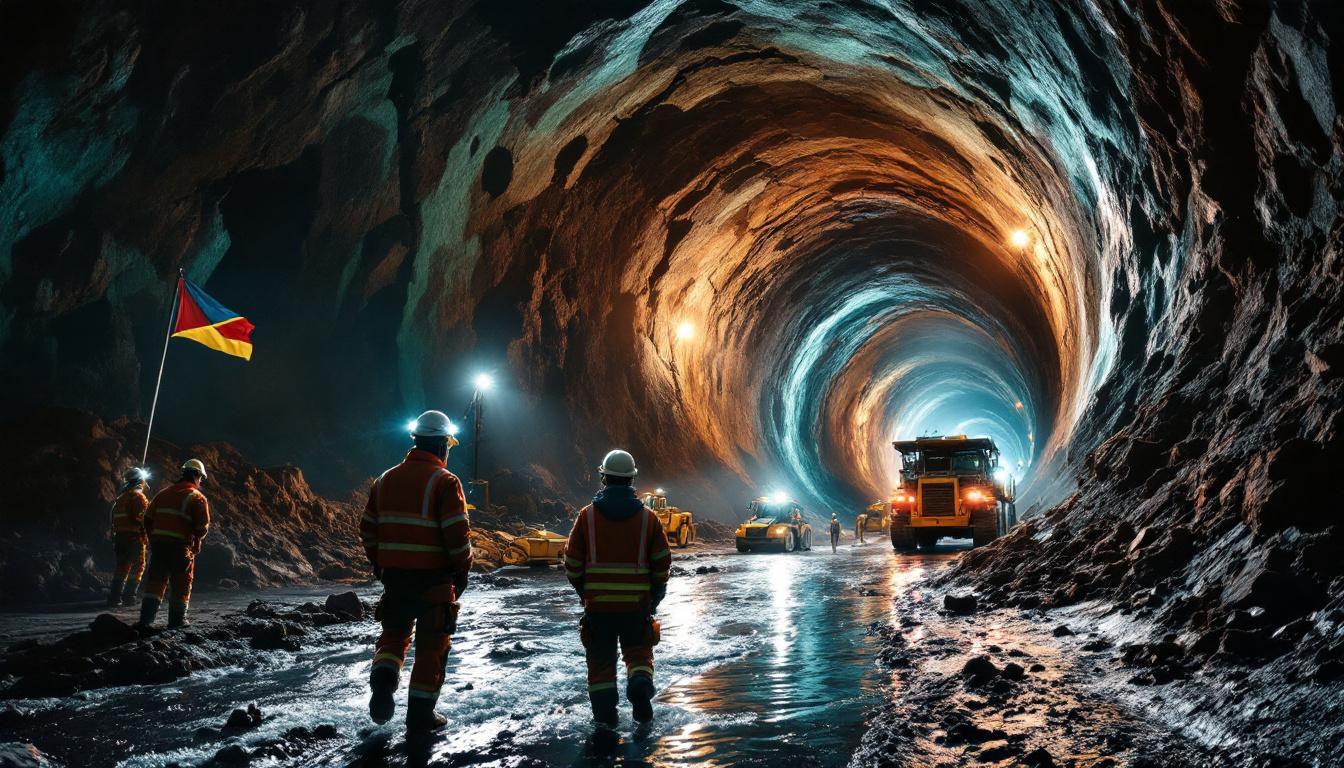Trump's Executive Order on Seabed Mineral Exploration: Strategic Implications and Industry Impact
President Donald Trump's executive order on seabed mineral exploration, signed on April 25, 2025, marks a pivotal shift in U.S. resource policy. The directive aims to accelerate domestic capabilities in deep-sea mineral exploration, processing, and commercialization to reduce reliance on foreign critical minerals, particularly from adversarial nations like China. By streamlining permitting processes and fostering public-private partnerships, the order seeks to position the U.S. as a global leader in seabed resource development while addressing national security and economic priorities. However, environmental groups caution against irreversible biodiversity loss, highlighting tensions between resource security and conservation.
Understanding the Executive Order
What Does Trump's Seabed Mineral Exploration Order Entail?
The executive order mandates rapid development of U.S. capabilities in exploring, characterizing, collecting, and processing critical seabed minerals within and beyond national jurisdiction. It prioritizes minerals essential for advanced technology, defense systems, and clean energy infrastructure, such as cobalt, nickel, and rare earth elements. The Commerce Department is tasked with expediting permit reviews under the Deep Seabed Hard Mineral Resources Act, with a streamlined process required within 60 days of the order's signing. Notably, the order emphasizes reducing dependence on foreign suppliers, particularly China's mineral export restrictions, which currently dominates 80% of global rare earth mineral processing.
Key Objectives and Strategic Goals
The order's primary objectives include strengthening domestic supply chains, countering China's strategic control over seabed resources, and achieving resource independence for national security. It aligns with broader Trump administration policies, such as the April 2025 coal production orders, which similarly prioritized domestic energy independence despite environmental criticisms. By accelerating permit approvals and incentivizing private-sector investment, the administration aims to create a self-sufficient critical minerals ecosystem, reducing vulnerabilities in sectors like semiconductor manufacturing and renewable energy.
Implementation Timeline and Government Actions
60-Day Implementation Requirements
Within 60 days, the Commerce Secretary must establish a framework for expedited exploration and commercial recovery permits, bypassing traditional bureaucratic delays. Concurrently, the Interior and Energy Departments are directed to identify high-potential exploration zones in the U.S. Outer Continental Shelf, focusing on polymetallic nodules rich in cobalt and nickel. The Defense and Energy Departments will also assess integrating seabed-derived minerals into the National Defense Stockpile, which currently holds less than 10% of the Pentagon's annual critical mineral needs.
Interagency Coordination and Responsibilities
The order mandates collaboration across six federal agencies: Commerce, Interior, Energy, Defense, State, and the U.S. International Development Finance Corporation. The State Department is tasked with negotiating international partnerships, particularly with Pacific allies like Japan and Australia, to counter China's deep-sea mining activities in contested regions such as the Clarion-Clipperton Zone. Meanwhile, financial institutions like the Export-Import Bank are instructed to develop loan guarantees and insurance products to mitigate private-sector risks in deep-sea ventures.
Economic and Strategic Implications
Critical Minerals Supply Chain Security
The U.S. imports over 50% of its critical minerals, with China controlling 60% of global production and 85% of processing capacity. By developing domestic seabed resources, the order aims to slash reliance on adversarial nations while creating a vertically integrated supply chain—from extraction to processing—for minerals vital to electric vehicle batteries and wind turbines. The Defense Department's involvement underscores concerns over China's potential to weaponize mineral exports during geopolitical crises, akin to its 2010 rare earth embargo against Japan.
Public-Private Partnership Opportunities
Private companies engaged in seabed exploration gain access to federal loan programs and streamlined permitting, reducing upfront capital barriers. Startups like DeepGreen (now The Metals Company) have already secured over $300 million in funding for nodule collection technologies, signaling investor confidence. The order also encourages technology transfers from defense contractors and aerospace firms, leveraging existing expertise in remote-operated vehicles and underwater robotics. Analysts project the deep-sea mining market could grow from $650 million in 2024 to $15.3 billion by 2030 if regulatory hurdles are minimized.
Environmental Considerations and Controversies
Environmental Impact Concerns
Environmental groups, including the Deep Sea Conservation Coalition, warn that seabed mining could destroy fragile ecosystems, such as hydrothermal vent communities that take millennia to form. Over 700 marine scientists have endorsed a moratorium, citing irreparable harm to biodiversity and carbon sequestration processes in ocean sediments. The order's provisions for environmental monitoring technologies, such as AI-driven impact assessments, remain untested at commercial scales, raising skepticism among conservationists. According to The Guardian's report on Trump's deep-sea mining executive order, these environmental concerns have sparked significant opposition from scientific communities worldwide.
Balancing Resource Needs and Conservation
Proponents argue that seabed mining could reduce land-based mining's environmental footprint, which accounts for 10% of global deforestation and 20% of freshwater pollution. For example, extracting cobalt from polymetallic nodules may generate 75% less carbon emissions per ton than terrestrial mining in the Democratic Republic of Congo. However, the order lacks enforceable safeguards, mirroring criticisms of Trump's 2025 coal orders, which relaxed mine reclamation requirements. Companies must address these mining ESG challenges to ensure sustainable practices.
International Implications and Geopolitical Context
Global Positioning and Alliances
The State Department is directed to negotiate joint exploration agreements with allies, offering U.S. technological expertise in exchange for resource-sharing agreements. This strategy targets China's Belt and Road investments in Pacific island nations, where Beijing has secured exclusive seabed mining rights in exchange for infrastructure financing. The U.S. also seeks to reform the International Seabed Authority (ISA), challenging China's dominance in setting deep-sea mining regulations. These developments require careful geopolitical investor strategies to navigate the complex international landscape.
Legal and Jurisdictional Considerations
The U.S., which has not ratified the UN Convention on the Law of the Sea (UNCLOS), faces credibility challenges in advocating for ISA reforms. Domestically, the order asserts jurisdiction over the Extended Continental Shelf, encompassing 1.7 million square kilometers of seabed beyond the 200-nautical-mile limit. This conflicts with Russia and Canada's claims in the Arctic, potentially escalating territorial disputes.
Future Outlook and Industry Impact
Technological Development and Innovation
The order prioritizes R&D in nodule collection systems, underwater hyperspectral imaging, and closed-loop processing technologies to minimize waste. Defense contractors like Lockheed Martin, which holds exploration licenses for U.K. seabed territories, could deploy autonomous submarines originally designed for anti-submarine warfare. Additionally, NASA-funded robotics for extraterrestrial mining may be adapted for deep-sea applications, accelerating commercialization timelines. These advances align with growing trends in digital mining innovations across the industry.
Long-term Economic and Strategic Implications
If successful, the U.S. could capture 25% of the global seabed mineral market by 2040, generating 40,000 jobs in marine engineering and metallurgy. However, reliance on unproven technologies and volatile mineral prices poses risks; lithium prices dropped 70% in 2023 due to oversupply, illustrating market unpredictability. Strategically, the order aligns with Pentagon initiatives to secure minerals for hypersonic missiles and quantum computing, ensuring military supply chain resilience. The battery minerals demand challenge remains a key driver behind these initiatives, as the clean energy transition increases pressure on mineral supplies.
FAQ: Key Questions About Trump's Seabed Mineral Exploration Order
What specific minerals are targeted?
Cobalt, nickel, manganese, and rare earth elements critical for batteries, electronics, and defense systems.
How does this affect international agreements?
The U.S. may bypass ISA guidelines, relying on bilateral deals that could fragment global governance.
What are the environmental risks?
Irreversible damage to deep-sea ecosystems and disruption of carbon storage processes.
How will this impact U.S.-China relations?
Escalates resource competition, particularly in the Pacific, where both nations vie for influence.
Opportunities for private companies?
Access to federal financing, expedited permits, and partnerships with defense contractors.
Comparison to previous administrations?
Diverges from Obama-era focus on terrestrial mining and Biden's pause on seabed leases for environmental review.
This comprehensive analysis underscores the order's potential to reshape global mineral markets while highlighting unresolved tensions between economic ambition and environmental stewardship. Future success hinges on technological innovation, international diplomacy, and balancing stakeholder interests in uncharted regulatory waters.
Looking to Spot the Next Major Mineral Discovery?
Stay ahead of significant ASX mineral discoveries and potential investment opportunities with Discovery Alert's proprietary Discovery IQ model, which instantly analyses announcements to identify high-potential discoveries as they happen. Explore why major mineral discoveries like those featured in Trump's policy can generate substantial returns by visiting Discovery Alert's dedicated discoveries page and start your 30-day free trial today.




